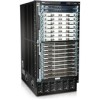Dell PowerConnect J-8216 Hardware Guide - Page 95
Calculating the J-EX8200 Switch Fiber-Optic Cable Power Budget
 |
View all Dell PowerConnect J-8216 manuals
Add to My Manuals
Save this manual to your list of manuals |
Page 95 highlights
Chapter 6: Cable Requirements • Modal dispersion, which is the spreading of the signal over time caused by the different propagation modes in the fiber. For multimode transmission, modal dispersion, rather than chromatic dispersion or attenuation, usually limits the maximum bit rate and link length. For single-mode transmission, modal dispersion is not a factor. However, at higher bit rates and over longer distances, chromatic dispersion limits the maximum link length. An efficient optical data link must have enough light to exceed the minimum power that the receiver requires to operate within its specifications. In addition, the total dispersion must be within the limits specified for the type of link in Telcordia Technologies document GR-253-CORE (Section 4.3) and International Telecommunications Union (ITU) document G.957. When chromatic dispersion is at the maximum allowed, its effect can be considered as a power penalty in the power budget. The optical power budget must allow for the sum of component attenuation, power penalties (including those from dispersion), and a safety margin for unexpected losses. Related • Calculating the J-EX8200 Switch Fiber-Optic Cable Power Budget on page 91 Documentation • Calculating the J-EX8200 Switch Fiber-Optic Cable Power Margin on page 92 • Optical Interface Support in J-EX8200 Switches on page 51 79















